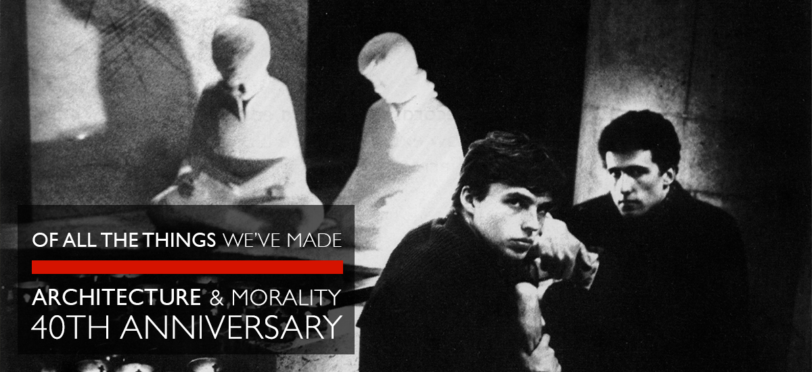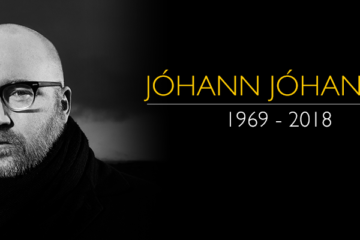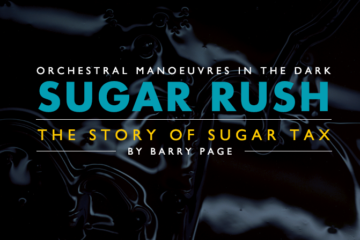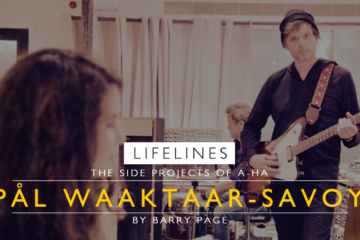To the shores of Sealand…
With an extensive musical career that stretches back over several decades, it’s understandable that many people will have their own particular favourite OMD album. Some plump for the band’s imperial phase (encompassing the first four albums), others favour OMD’s ‘American’ period, while other voices might opt for the band’s post-reformation output.
That said, most people will acknowledge that OMD’s third studio album, Architecture & Morality marked a particularly notable milestone in their synth-pop journey. Released in November 1981, the album saw a leap from the electro-punk of 1980’s OMITD album and the gothic Organisation the same year. Instead, OMD embraced choirs, mellotrons and tonal soundscapes wrapped up with an ethereal quality, yet still managed to deliver evocative pop songs that brought them more chart success.
It’s difficult perhaps to assess how odd Architecture & Morality was as an album back in 1981, the same year that saw the release of Soft Cell’s Non-Stop Erotic Cabaret (see TEC feature previously), The Human League’s Dare, Depeche Mode’s Speak & Spell and Kraftwerk’s Computer World. Consider that OMD’s album featured a title track that’s a bizarre cacophony of electronic sounds, ‘The New Stone Age’ utilises Eno-style thrash guitars, while ‘Maid Of Orleans’ employs a distorted, quirky intro and a military drum sound.
2021 sees Architecture & Morality celebrate its 40th Anniversary and also offers an opportunity to view the album with some perspective. It’s rightly considered a classic synth-pop album, but at the time Andy McCluskey and Paul Humphreys viewed it as the pinnacle of an intense musical path which had taken them from their native Wirral through to global commercial success. They couldn’t conceive of writing anything that could top the album at the time. Plus, the band had begun to express gloomy thoughts on where exactly the OMD journey was going (exacerbated by tensions with their record label).
There is certainly an element of frustration peppered across their third album, with ‘The New Stone Age’ seeing an anxious Andy implore “Oh my God, what have we done this time?” while there’s also elements of existential angst lurking on the likes of ‘Sealand’. Both the compositions inspired by Joan Of Arc, meanwhile, have a particularly desperate, yearning quality to them; a need to grasp something intangible that is always slightly out of reach.
“I think one of the things we always tried to do” commented Andy previously, “particularly in the early part of Orchestral Manoeuvres In The Dark, was desperately try not to repeat ourselves. It seemed to be an essential part of our kind of method was to try to do something we hadn’t done before. I think we were looking for a new direction and found a lot of influence in the emotional power of religious music. Although not the actual religious content, but just the actual emotional power of religious music…”
“…the music that I was listening to were a huge array of religious choral stuff, both modern and ancient, from Hildegard von Bingen, Tavener, just all sorts of masses and arias and glorias, all sorts of religious music and Russian folk music and Gregorian chants. I was really impressed with the power of massed voices. It was the emotional power that was generated by that sound that we wanted to get in.”
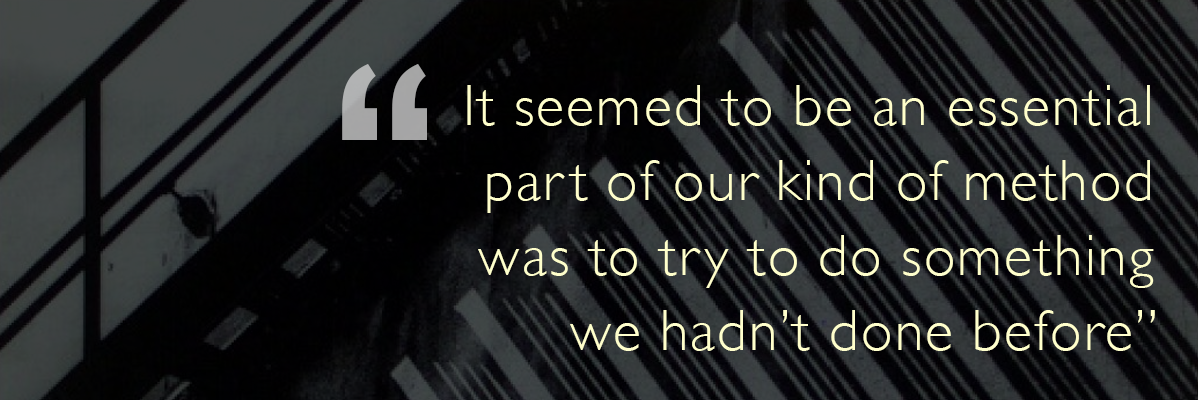
“Architecture & Morality was a culmination of everything we had learned to that point about song writing and about sound textures” recalled Paul Humphreys, “It was as if the two albums prior to it were leading and directing us towards this piece of work. To me this album was our finest hour. Together, and separately, Andy and I have written some really good songs – before and after this album – but in terms of an album, this ‘collection’ of our songs hang together the most successfully for me.”
Prior to all this, OMD had spent part of 1980 engaged on their first US tour, which was in tandem with a record deal with Epic. Subsequently, a hybrid album was released which contained cuts from both OMITD and Organisation. The band felt that Epic were not really sure how to handle a synth-pop outfit from the UK and it certainly didn’t bring them huge commercial success.
Returning to the UK, Andy and Paul tried to forget all this by burying themselves in writing new material. They retreated to their own studio, The Gramophone Suite, nestled in the heart of Liverpool’s city centre. “We didn’t like the clean, clinical sound you get in most big studios” commented Paul Humphreys in an issue of Electronics and Music Maker at the time, “Our mixing desk is really battered and has a lot of channel distortion which gives a wonderful, graunchy edge to our sound.”
The first song to emerge from these early sessions was titled ‘Georgia’ which had a bold, percussive sound but didn’t have the right elements as a possible single and was shelved as a result (this track would later emerge as a B-side to 1988 single ‘Dreaming’ where it was retitled ‘Gravity Never Failed’).
Around the same time, Dave Hughes (who was already a member of the extended OMD family) had been using the studio to experiment with tape loops from a pre-recorded 8-piece choir tuning up. As thanks for the use of the studio, Hughes left a copy of the loops behind. Paul Humphreys and Martin Cooper worked with the loops to produce what was initially a very abstract song.
“Paul had asked me to go to the studio to do a bit of writing with him” Martin Cooper commented on the song’s creation, “…Dave Hughes had given Paul some tape loops of people singing long straight notes. These were arranged into chords and blended around a chord sequence that Paul had been working on. The song gradually evolved from there.”
Initially titled ‘Choir Song’, the composition was much slower in its original incarnation, but the choral sounds had a strange, haunting quality that marked this track out as something special. It was eventually titled ‘Souvenir’ and became the de facto first song for what would become Architecture & Morality. “I think that the discovery of mixing choral sounds with electronics, set the tone for the other pieces that followed” mused Paul Humphreys on the first foundation block of the album.
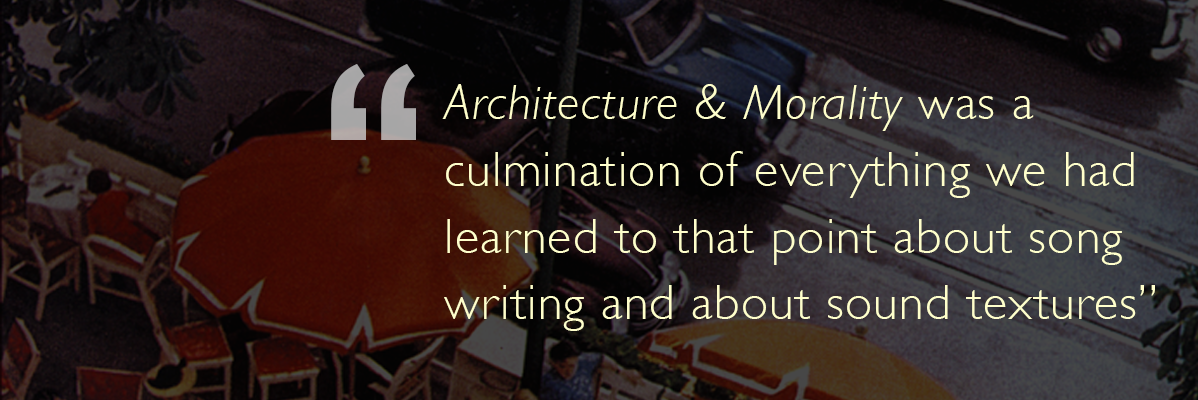
The song certainly caught the imagination of producer Mike Howlett who convinced the band to go into Wessex Studios to record it. Despite the fine job Mike Howlett did in producing the song, Andy had misgivings about the composition being too soft and wanted to toughen it up a bit. As a result, the band consequently recorded another version from scratch at a session in Advision Studios. But when they compared both versions, they were forced to agree that Mike Howlett’s take yielded more depth and atmosphere.
Meanwhile, as with ‘Georgia’, there were more false starts on other tracks being written at the time. While on tour in France earlier that year, Andy had been captivated by the story of Joan Of Arc and was determined to write a song about the iconic French saint. But the song, written in waltz time, didn’t appear to be working from Andy’s perspective and it was shelved. Instead, he conjured up a fresh idea and penned a composition that would become ‘Joan Of Arc’ (which was actually written on the anniversary of her death, 30th May 1981).
By this stage, the band had assembled enough material to shape up for an album and booked in time at The Manor, Richard Branson’s recording studio based in Shipton-on-Cherwell. On the day that they were packing up their gear to relocate to the studio, Paul and Mal queried Andy about the earlier version of ‘Joan Of Arc’ that he had worked on, convinced that it could be shaped up into a workable song. Won over by their argument, the fledgling track was packed up with the rest of the demo material.
Meanwhile, OMD’s team suffered a setback when Martin Cooper announced that he was leaving the band in May that year. At the time, Martin felt restricted by the tight-knit writing unit of Andy and Paul and was keen to embark on his own musical projects. Subsequently, Martin teamed up with Dave Hughes to form the baroque synth outfit Godot.
Realising that OMD would still require an additional keyboard player for any forthcoming live shows, they pulled in local musician Mike Douglas. This ‘musical chairs’ element was short-lived when Martin later grew dissatisfied with Godot’s direction and, following the release of Architecture & Morality, returned to the band.
One of Architecture & Morality’s strengths is in its percussion as Mal Holmes recalled: “On Organisation we used real drums. With Architecture & Morality I sort of was able to let my hair down a little bit more and we could get a little bit more experimental with sounds on drum parts.”
“I was listening to military marching music like the Edinburgh Tattoo and stuff like that” suggests Andy, “So I was into this idea of big, massed drums, so ‘Maid Of Orleans’ was a big BOOM-TCH-TCH, BOOM-TCH-TCH you know, and also the drums on ‘Romance Of The Telescope’ are very specifically trying to emulate the sound of the drums from pipe bands, the Edinburgh Military Tattoo.”
“The textural sounds and inspiration came mainly from our discovery of a wonderful machine call a Mellotron” comments Paul, “This provided the sound beds and the atmospheres for the pieces and added together with our natural – and Eno-inspired – desire to experiment, made this a quite unique piece of work.”
OMD tested the waters with their new sound concepts when ‘Souvenir’ was released as the album’s lead single in August 1981. The band’s confidence was bolstered when it managed to reach No. 3 in the UK charts. Not everyone was convinced, however. Smash Hits gave it a particularly hard time in their review: “The futurist gag goes lush life. An early sixties girl group type song slowed down to grass-growing speed. I preferred them when they were still OMITD. Since then, they seem to have lost IT.”
The Manor sessions, meanwhile, continued with the band also working alongside Richard Manwaring on production duties. “OMD were flexible enough to take on ideas I suggested, technically as well as musically” commented Richard in the Pretending To See The Future book. The mutually beneficial working arrangement meant that the raw material was quickly shaped up into songs that would later become OMD classics. ‘She’s Leaving’ (originally written in January 1981) had been trialled during the band’s French tour, albeit in a faster, more dynamic incarnation. The band’s attempts to record it resulted in them getting bored very quickly. It was only when they discovered an old version recorded at The Gramophone Suite that they tried again. Recording at The Manor, they slowed it down and made it a bit simpler.
Despite the fact that the band were recording in a professional studio, they were still keen to keep something of their garage electro-punk ethic in the process. “Electronic music often sounds too clinical because synthesisers are usually D.I’d (direct input) into mixing desks” the band commented in Electronics and Music Maker at the time, “so because there’s no microphone involved you don’t get the speaker distortion or the amp distortion. We sometimes mike things up to restore that. We also have an ambient room down at The Manor studio where we mike things up at a distance and get a big, boomy sound.”
‘Sealand’ was a sister track in some ways to ‘Stanlow’ from OMD’s previous album Organisation. It was similarly composed as a tonal soundscape which had more to do with mood and ambience, as opposed to a 3-minute pop song. The title was derived from a RAF base on the Wirral, although the song isn’t about the location itself. Andy was struck by the visual strength of the name, which seemed to conjure up a striking image of a place between the land and the sea.
‘The Beginning And The End’ was an old song dating from Andy and Paul’s VCLXI days. Back then, the band had problems in getting it to sound right and they remarked in an issue of the OMD Newsletter that the version used on the album was “quite successful” but that perhaps they would do it again differently in the future.
The album’s title track was a collage of different (often jarring) sound ideas. “We wrote the whole thing in the Manor Studio in three days” the band declared in an issue of the OMD Newsletter at the time. “We decided to call it ‘Architecture & Morality’ and then proceeded to throw onto tape everything ‘architectural’ and ‘moral’ that we could think of. Over the three days we gradually added and subtracted all manner of sounds until we had made something from all the noises.”
Having resurrected the original take on ‘Joan Of Arc’, the band solved the issue of the shortness of the song by bolting on an extended intro. To distinguish it from the new song it was also given a weightier title: ‘Maid Of Orleans (The Waltz Joan Of Arc)’. The composition is dominated by Mellotron sounds (specifically, its ‘3 Violins’ sound), so it seemed to make sense to continue using that as the foundation for the intro. Much of that opening segment for ‘Maid Of Orleans’ is actually Mellotron sounds that have been distorted by overdriving the Helios mixing desk in The Manor.
‘The Romance Of The Telescope’ takes its title from a chapter in a book of astronomy. Due to the short period involved in recording the track (one day’s work) Andy and Paul decided to label the song as ‘unfinished’. However, with hindsight, they liked the song and decided it was fine as a finished track (it was later ‘rescued’ and utilised as an album track on OMD’s 1983 album Dazzle Ships).
Having wrapped up recording at The Manor, the band then relocated to Mayfair Studios in September 1981 for mixing. “We had so many problems when we were mixing the second album at Ridge Farm with the computer on the SSL desk that we refused to use a computer for mixing at Mayfair” recalls Andy on the album’s mixing process, “Even though we were supposed to be this technical cutting-edge electronic band, computer technology had just come into use on mixing desks and we refused to use it because it had such a bad time on the second album that every single mix was all done manually. You know, there’d be three or four of us on the desk going “Right, you push the snare drum up in that bit and I’ll move this down to this mark and then switch on the reverb in that bit and switch it back up again!” (laughs).
“So, all of the mixes were done manually-ridden. You know, pushing things up and pulling things down rather than using computer automation because we had so many technical problems when we were mixing Organisation.”
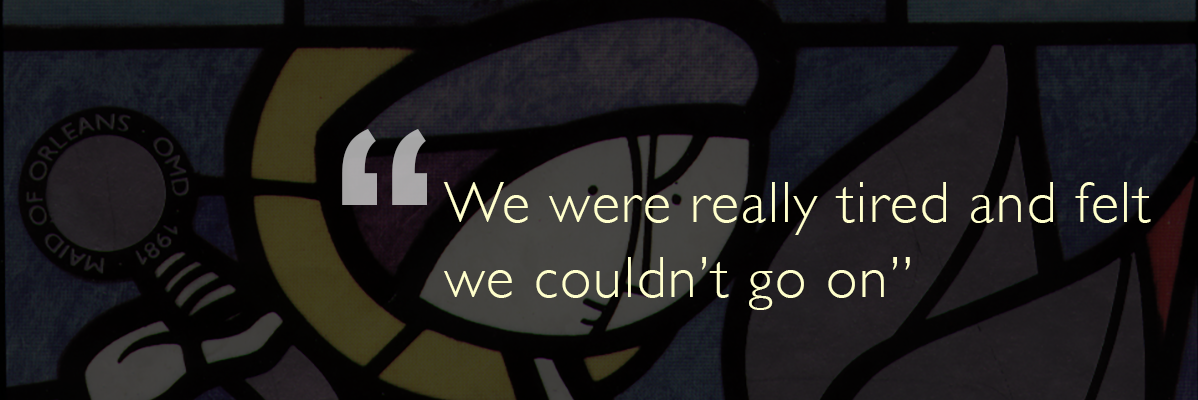
Once mixing was completed, the band didn’t have much opportunity for a break. They were launched into another series of American dates that took them through late September and October. Then it was back to the UK in November for the start of the Architecture & Morality tour. The night before the tour kicked off even saw Andy and Paul back in the studio to record a B-side (‘Of All The Things We’ve Made’) for forthcoming single ‘Maid Of Orleans’. “We were really tired and felt we couldn’t go on” reflected Andy on the early morning studio session, “We thought it would be the last song we’d ever write, ‘Of All The Things We’ve Made’ would be our epitaph. We’d had enough.”
That punishing routine coupled with the band’s grumblings about their record deal boiled over into press features at the time.
In a particularly damning piece in Record Mirror, Andy and Paul found an outlet to vent about their grievances. “It’s been a case of work, work, work – seven days a week, eighteen hours a day” griped Paul. Meanwhile, Andy mused that their reward for selling millions of records had been “a somewhat ostentatious tour bus and a recording studio.”
But despite the problems that the band were wrestling with in the machinations of the music industry, the November release of Architecture & Morality demonstrated that OMD were a force to be reckoned with.
“Orchestral Manoeuvres success through trial and error, sometimes failing to get the complete point across” commented Daniella Soave in her review for Record Mirror, “What matters though, is the emotion and atmosphere they pour into their work, so much that their songs conjure vivid visual images.”
Meanwhile, Smash Hits were equally jubilant in their review: “OMD are literally back on song, reigning in their more ambitious ideas into concise but varied and imaginative arrangements that actually boost instead of swamp their wonderful melodies and intelligent lyrics (9 out of 10).”
The album didn’t receive praise across the board. Lynden Barber’s Melody Maker review was more scathing: “I don’t believe the Orchs even care about this record… the style is the same, the content profoundly different, the onslaught of emptiness, frivolity disguised by furrowed brows, a new brand of meaninglessness.”
Yet Architecture & Morality went on to sell four million copies, while spawning three international hit singles. Meanwhile, with the band given a higher profile, their dynamic live performances drew in more fans enthralled by the balance between thoughtful, moody soundscapes and hook-laden pop songs.
As the album celebrates its 40th Anniversary, it’s not an over-estimation to put Architecture & Morality in its place as not just a classic OMD album, but also a classic album full-stop. It embraced the idea that with some albums you need to take time to appreciate them. The odder, quirkier elements of the album capture the imagination, while also serving as a counterpoint to the hit singles, resulting in a delicate balancing act.
For Paul Humphreys and Andy McCluskey, the album’s timeless and evocative qualities have preserved its legacy over four decades. “The fact that it opposed the current trends, turned out to be its ultimate strength” reflects Paul.
Andy, equally, recognises the album’s odd qualities as being in its favour: “I think one of its strengths is that so many of the tracks were not conceived to be pop songs and therefore the album, in many respects, was not an album of its time which allows it to stand the test of time better. Because I don’t think an awful lot of music on there necessarily sounds like 1981. It didn’t sound like 1981, even in 1981!” (laughs)
OMD have released Architecture & Morality (The Singles) – 40th Anniversary , a special collation of the various singles, B-sides, unreleased tracks and live versions. Read our review here.
This review originally appeared on Messages.


